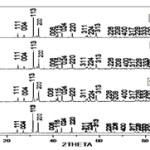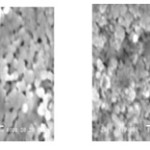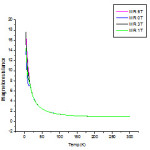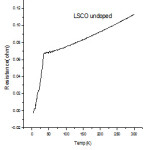Synthesis Growth and Characterization of La1.8m0.20cu1-Xmnxo4, (M=Sr,Ca) Oxides
Manish Verma1, B. Das1,N. P. Llala2, D.M. Phase2 and V. K. Ahire2
1Department of Chemistry, University of Lucknow - 226 007 (India). 2UGC-DAE CSR,University Campus,Khandwa Road,Indore - 452 017 (India).
Polycrystalline samples of La1.8M0.20Cu1-xMnxO4 (0d”xd”0.20) were synthesized by solid state reaction method. The phase purity was confirmed by powder X-ray diffraction. The scanning electron microscopy was done on the La1.8M0.20Cu1-xMnxO4 samples. The La1.8Sr0.20Cu1-xMnxO4 sample was found to be superconducting while La1.8Ca0.20Cu1-xMnxO4 sample was found to be magnetoresistive.
KEYWORDS:Solid state reaction method; X-ray diffraction; Scanning Electron Microscopy; Microstructure; SEM; Magnetoresistance; LSCO; LCCO
Download this article as:| Copy the following to cite this article: Verma M, Das B, Llala N. P, Phase D. M, Ahire V. K. Synthesis Growth and Characterization of La1.8m0.20cu1-Xmnxo4, (M=Sr,Ca) Oxides. Orient J Chem 2012;28(2). |
| Copy the following to cite this URL: Verma M, Das B, Llala N. P, Phase D. M, Ahire V. K. Synthesis Growth and Characterization of La1.8m0.20cu1-Xmnxo4, (M=Sr,Ca) Oxides. Available from: http://www.orientjchem.org/?p=23553 |
Introduction
There is now extensive research work on lamellar copper oxide materials to explain the mechanism of various phenomenons in oxides [1-6]. To study the phenomenon like superconductivity, magnetoresistance & other physical properties the doping of various elements at Cu site was done by various research groups [5-7]. In this paper we attempt to explain the accurate condition.
Materials and Methods
The polycrystalline samples were prepared by means of a conventional solid state reaction method using high-purity powders of La2O3, SrCO3/CaCO3, CuO, and MnO2. The powders were mixed, pressed into pellets, were then reacted at 1100ºC for 7 days with three intermediate grinding. The chemical formula for the final compounds is La1.8M0.20Cu1-xMnxO4 with x=0, 0.10, 0.15, 0.20 & M=Sr/Ca. Phase identification was done with the help of X-ray Diffraction (XRD) pattern recorded on powder Rikagu Diffractometer using Cukα radiation. Rikagu Diffractometer has scanning rate of 2 degree per minute. Microstructure was analyzed by Scanning Electron Microscopy (SEM) JEOL JSM 5600. Also EDAX was done on these samples to map the elements present in samples (not shown). Resistance as a function of temperature for all the samples of LSCO was measured using a standard four-probe method. Magnetoresistance (MR) was measured as a function of Temperature.
Results and Discussion
Each sample of La1.8Sr0.20Cu1-xMnxO4 & La1.8Ca0.20Cu1-xMnxO4 was carefully characterized by powder X-ray diffraction and confirmed to be single phase which can be indexed as having K2NiF4-type tetragonal symmetry (not shown) & Orthorhombic symmetry respectively (see figure 1). No impurity peaks are present in the X-ray Diffraction patterns. Mn definitely substitutes for Cu site as confirmed by the fact that the samples with Mn doping remain single phase.
 |
Figure 1: X-ray diffraction of LCCO i.e.
La1.8Ca0.20Cu1-xMnxO4with x=0,0.10, 0.15,0.20 |
 |
Figure 2a: LSCO, y=0 and Figure 2b: LSCO |
The SEM pictures of the LSCO samples with irregular grain size <1 µm are shown in fig. 2a, fig.2b. We observe the grains are randomly distributed and there is low intergrain porosity. The SEM of LCCO (not shown).
 |
Figure 3: The magnetoresistance (MR) of La1.8Ca 0.2Cu0.85Mn0.15O4. |
The figure 3 shows that the MR of La1.8Ca0.2Cu0.85Mn0.15O4 decreases with increasing temperature due to less scattering from Mn at constant magnetic field of 0,1,3,5 tesla. Thus LCCO is magnetoresistive oxide.
 |
Figure 4: R-T plot for undoped LSCO. |
Figure 4 shows the temperature dependence of resistance of the La1.8Sr0.20CuO4.For undoped LSCO the transition temperatures was measured to be 36.766k.
Conclusion
In summary, the polycrystalline samples of La1.8Sr0.20Cu1-xMnxO4 (LSCO) & La1.8Ca0.20Cu1-xMnxO4 (LCCO) were synthesized using solid state reaction method. The powder XRD shows that La1.8Sr0.20Cu1-xMnxO4 was tetragonal K2NiF4 type phase which is well suited for polycrystalline sample while La1.8Ca0.20Cu1-xMnxO4 was orthorhombic symmetry. The La1.8Ca 0.2Cu0.85Mn0.15O4.
sample was found to be magnetoresistive while the La1.8Sr0.20CuO4 sample was found to be superconducting. These different effects need further study.
Acknowledgements
The authors express their thanks to Dr.J.S.Verma, Dr.R.P.singh & Dr B.Das for their technical supports and discussion in the La1.8Sr0.20Cu1-xMnxO4 & La1.8Ca0.20Cu1-xMnxO4 samples synthesis and characterization. This work was supported by UGC-DAE-CSR, Indore (India) and University of Lucknow (India).
References
- E. Cohen, G. Deutscher, Physica C 454 (2007) 1.
- T. Park, Z. Nussinov, K.R.A. Hazzard, V.A. Sidorov, A.V. Balatsky, J.L. Sarrao, S.-W. Cheong, M.F. Hundley, Jang-Sik Lee, Q.X. Jia, J.D. Thompson, Phys. Rev. Lett. 94 (2005) 17002.
- T. Kawamata, M. Yamazaki, N. Takahashi, T. Adachi, T. Noji, Y. Koike, K. Kudo, N. Kobayashi, Physica C 426 (2005) 469.
- T. Churei, H. Hiraka, Y. Endoh,M.Matsuda, K. Yamada, Physica C 392–396 (2003) 194.
- T. Kawamata, T. Adachi, T. Noji, Y. Koike, Phys. Rev. B 62 (2000) R11981.
- G. Xiao, Marta Z. Cieplak, J.Q. Xiao, C.L. Chien, Phys. Rev. B 42 (1990) 8752.
- arxiv.org/pdf/cond-mat/0108151

This work is licensed under a Creative Commons Attribution 4.0 International License.









